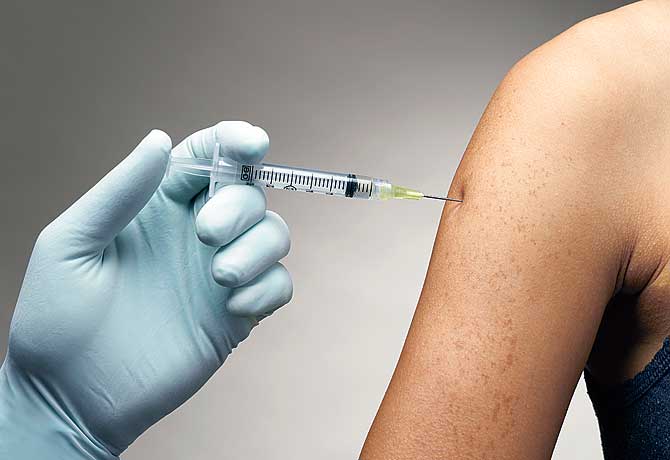
Vaccines enlist the immune system in the battle against cancer. Treatments would begin after surgery and chemo, to prevent relapse.
(3 of 4)
Schwartzentruber thinks he has a way around that problem. In some trials, after giving his vaccine to patients with advanced melanoma that has spread to other tissues, he adds an immune stimulator called interleukin-2 (IL2) for reinforcement. Alone, the vaccine would not cause any tumors to shrink. The IL2 treatment itself wasn't very effective either; it shrank tumors in only 10% of patients. But combining the vaccine and IL2 has caused tumors in 22% of patients to regress — a doubling of effectiveness. "This teaches us a lesson: that combinations of biologic treatments are more powerful than their individual components," says Schwartzentruber.
Kwak and his collaborators, led by Dr. Stephen Schuster at the University of Pennsylvania, see a similar power in pairing. Their vaccine, against a form of non-Hodgkin's lymphoma known as follicular lymphoma, takes a slightly different, more personalized approach. Rather than relying on a commonly found antigen or snippet of cancer protein to teach the body to recognize the malignancy, they designed each vaccine using individual patients' specific lymphoma profiles. They then partnered this customized concoction with another immune stimulator, GMCSF. Patients receiving the combination remained in remission on average 44 months after the vaccination, a 47% improvement in disease-free survival compared with those getting the uncustomized vaccine, who stayed in remission for just 30 months.
This study is also the one that yielded the most evidence that the best time to inoculate patients is when they're in remission from their disease. While Schwartzentruber elected to administer his melanoma vaccine when his subjects were in the most advanced stages of illness, Kwak and his colleagues decided to capture the immune system at its best. They waited until the patients had been in remission for six months after chemotherapy, which rid the body of the bulk of the tumor burden. Give the immune system a break from that life-or-death battle, and it might be better able to do the surveillance work of corralling stray cells that escape the initial treatment. "I envision that vaccine approaches like this could be useful as maintenance therapy," says Kwak, who is the chairman of the department of lymphoma and myeloma at MD Anderson Cancer Center in Houston. "We would use chemotherapy and surgery to debulk the tumor and then vaccinate to maintain remission."
The Riddle of Success
Another way to make a vaccine more effective might be to manipulate the very nature of the tumor, so that it is a more obvious target for the immune system — a little like tying a more colorful fly on a fishing hook. The idea, says Dr. Patrick Hwu, chair of melanoma oncology at the University of Texas' M.D. Anderson Cancer Center and a member of Schwartzentruber's team, is to "get the tumor itself to look like a virally infected site, to get the whole immune system going."
The untreated immune system is not helpless in all of this. Rosenberg has biopsied tumors and extracted immune cells called lymphocytes from patients with advanced cancer and has grown these cells in culture. In a test tube, the lymphocytes are perfectly capable of killing tumor cells. But in the body, for some reason, they can't seem to stop a lesion from growing. So for melanoma, some researchers are working with a cream that can increase a tumor's "foreignness" to the immune system, tagging it to look more like an unwelcome virus and less like a familiar self cell. Other groups are testing ways to shut off the immune suppressors that the tumor sends out to hinder the natural seek-and-destroy tendencies of the immune system. That makes sense. Supercharging the immune system while the immune suppressors are still at work is a little like revving a car engine without releasing the emergency brake: in both cases, you're not going anywhere. And yet most early vaccine efforts have involved stepping on the gas alone.
One other way to get the immune system moving might be, in effect, to replace it with an entirely new one, says Rosenberg. If a vaccine can marshal the body's defenses to recognize and destroy a tumor, could you rebuild those defenses from the ground up and this time design them so they'll be especially good at fighting cancer cells?
Rosenberg's thinking is based on the now familiar strategy of the bone-marrow transplant for leukemia and lymphoma, which are blood- and immune-cell cancers. Radiation is used to obliterate a patient's cancer-tainted immune cells; those cells are then replaced by a population of new ones harvested from a healthy donor or grown from some of the patient's healthy cells. Rosenberg refines this method for melanoma by first exposing immune-system cells to tumor cells in a dish, thus "training" them to sprout proteins that target cancer cells, and only then infusing them into patients. Already he has shown that such a fortified mix can cause tumor regression in up to 70% of melanoma patients.